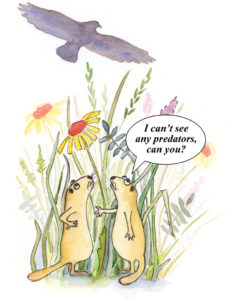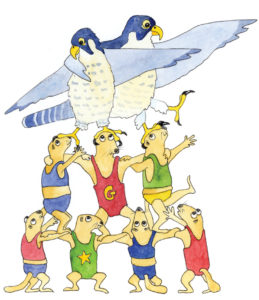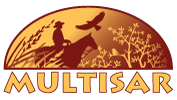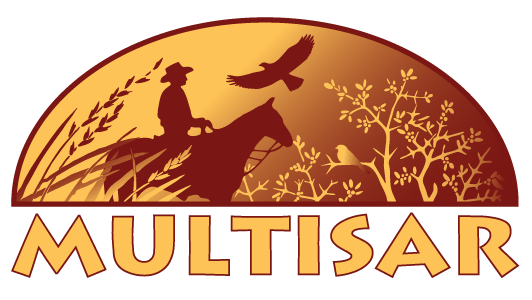Richardson’s Ground Squirrel
Spermophilus richardsonii
What’s in a Name?
While “Richardson’s Ground Squirrel” is the proper name for these prairie rodents, many people refer to them fondly (or perhaps not so fondly) as “gophers”. True gophers, such as Alberta’s Northern Pocket Gopher, are quite different animals which spend almost 100% of their life underground.
Underground Lifestyle
At times it may seem that there are ground squirrels everywhere, but they only spend about 15% of their life above ground. Adult squirrels hibernate for 7 – 8 months of the year. Even when they are not hibernating, they spend all night and considerable parts of the day in their burrows.

Richardson’s ground squirrels prefer to live in areas of short grass so that they can see predators approaching.
Can’t See the Predators for the Grass
Ground squirrels have a distinct preference for short grass. When the vegetation is tall, they cannot see very far and are more vulnerable to being caught by a predator. This is one of the reasons they find mowed parks and roadsides so attractive.
Supporting Species at Risk

Richardson’s ground squirrels are a keystone species – meaning they are extremely important in the life cycle of other animals.
Richardson’s Ground Squirrels are an essential part of the prairie ecosystem. This keystone species is the main food source for many prairie predators, including Species at Risk such as the Ferruginous Hawk, Prairie Falcon, Burrowing Owl and Swift Fox. In addition, their burrows provide shelter and nest sites for Prairie Rattlesnakes, Burrowing Owls, Tiger Salamanders, invertebrates and other prairie wildlife.
Population
Richardson’s Ground Squirrels are not considered to be at risk, but because they support many prairie species, a healthy population of squirrels is critical to the survival of Species at Risk. The abundance of some predators, such as Ferruginous Hawks, is closely tied to the availability of ground squirrels.
There have been no comprehensive population studies in Alberta, but like many rodents, their numbers cycle up and down. When numbers are high in an area, this attracts predators, which in turn can cause a local population decline.
Since 2003, population trend surveys have been conducted in southern Alberta. Results from sites near Lethbridge, Brooks and Medicine Hat show wide fluctuations from year to year, ranging from one squirrel per square kilometer to 20 /km2, with an average of 10.4 squirrels/km2.
Current Threats
- Human control of ground squirrels because of their nuisance activity (digging burrows, consuming agricultural products and the perception of competition with livestock for food).
- Collisions with vehicles are common, especially when the young first emerge from their burrows.
Species@Risk Quiz
Test your knowledge about Alberta’s grassland species at risk
Richardson's Ground Squirrel
Question 1 |
Richardson’s Ground Squirrels are above ground for:
90% of their life
| |
50% of their life | |
15% of their life |
Question 2 |
Richardson’s Ground Squirrels eat:
Grasshoppers
| |
Green plants and seeds | |
Meat and eggs | |
All of the above |
Question 3 |
Which Species at Risk rely on ground squirrels for food?
Trumpeter Swan and Piping Plover
| |
Ferruginous Hawk, Prairie Falcon and Swift Fox | |
Short-horned Lizard and Great Plains Toad | |
All of the above |
Question 4 |
Which prairie species rely on ground squirrel burrows?
Prairie Rattlesnake
| |
Burrowing Owl | |
Tiger Salamander | |
All of the above |
Public
- Take the time to stop and watch the ground squirrels around you. In urban settings, they are quite used to human activities, making them relatively easy to observe.
- Support native grassland habitat by choosing grass-fed meat in the grocery store.
- Voice your support for native grassland conservation with your political leaders.
- Educate yourselves and your family about Richardson’s Ground Squirrels and their key role in the grassland ecosystem.
Landowners
- Tolerate ground squirrels if they are not causing excessive damage, especially on marginally productive land.
- Tolerate predators of ground squirrels, such as badgers, to assist with keeping their numbers in check without having to rely on artificial means of control.
- Encourage tall vegetation to make tame pasture and native grassland less attractive to squirrels and keep their populations at acceptable levels.
- Remember that ground squirrel burrows provide necessary habitat for species at risk such as the Burrowing Owl, the Swift Fox, Prairie Rattlesnake and even pollinators such as bumble bees!
- Refrain from using poisons to control ground squirrels, as they affect other wildlife, both directly and indirectly.
- Talk to a MULTISAR biologist to assess whether installing a raptor nesting platform to attract natural predators could be a viable option on your land or if there are alternative approaches to controlling ground squirrels that might work for you.
What MULTISAR Does
- Conducts periodic Richardson’s Ground Squirrel population surveys to better understand population trends and the relationship between squirrel abundance and Species at Risk populations.
- Works with landowners and electricity transmission companies to install nest platforms for Ferruginous Hawks to control ground squirrels in an ecologically-friendly manner.
- Cooperates with landowners to restore cropland to native grassland at appropriate locations.
- Provides information about Richardson’s Ground Squirrels, their role in the ecosystem and their importance to Species at Risk.









